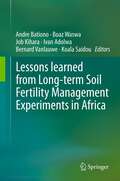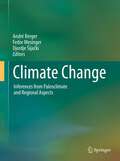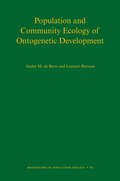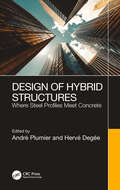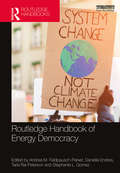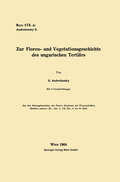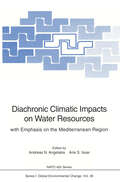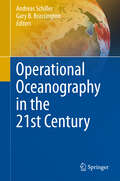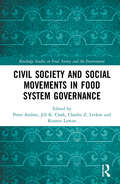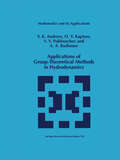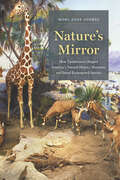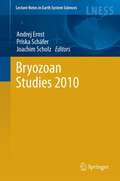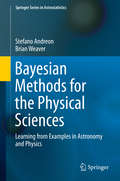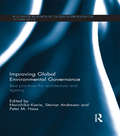- Table View
- List View
Lessons learned from Long-term Soil Fertility Management Experiments in Africa
by Andre Bationo, Boaz Waswa, Job Kihara, Ivan Adolwa, Bernard Vanlauwe and Koala SaidouThis book elucidates the importance of long-term experiments in revealing evidence of soil fertility decline in Africa. An evaluation of experiences from on-going long-term experiments is given in broad detail. The first chapter explains the paradigm shift in soil fertility management then provides justification for long-term experiments before illuminating experiences from long-term experiments in East, West and Southern Africa. The second, sixth, eighth and ninth chapters give an in-depth account of crop management practices and soil fertility interventions in long-term trials within specific agro-ecological zones in West Africa. The rest of the chapters (chapter three, four, five and seven) address crop management, tillage practices and, organic and inorganic fertilizer applications in the context of long-term experiments in specific agro-ecological zones in East Africa.
Climate Change: Inferences from Paleoclimate and Regional Aspects
by André Berger, Fedor Mesinger and Djordje ŠijačkiExperts in climate and water sciences from Canada, the United States, Brazil, Denmark, Germany, Belgium, France, Serbia, and other European countries and the UNESCO gathered at the Serbian Academy of Sciences and Arts on the occasion of the 130th birthday anniversary of the geophysicist Milutin Milankovitch. The collection of their presentations is opened by an update on the climate situation after the Fourth Assessment Report of the Intergovernmental Panel on Climate Change. Further topics include various issues of paleoclimatology, in particular as it helps reduce uncertainties from which prospects for climate change suffer; ecohydrology and climate change at the watershed scale; and regional climate models, which are discussed in terms of both their improved modeling and their use in studies of a polynya in the Antarctica and expected changes in the Mediterranean region.
Population and Community Ecology of Ontogenetic Development
by André M. de Roos Lennart PerssonMost organisms show substantial changes in size or morphology after they become independent of their parents and have to find their own food. Furthermore, the rate at which these changes occur generally depends on the amount of food they ingest. In this book, André de Roos and Lennart Persson advance a synthetic and individual-based theory of the effects of this plastic ontogenetic development on the dynamics of populations and communities. De Roos and Persson show how the effects of ontogenetic development on ecological dynamics critically depend on the efficiency with which differently sized individuals convert food into new biomass. Differences in this efficiency--or ontogenetic asymmetry--lead to bottlenecks in and thus population regulation by either maturation or reproduction. De Roos and Persson investigate the community consequences of these bottlenecks for trophic configurations that vary in the number and type of interacting species and in the degree of ontogenetic niche shifts exhibited by their individuals. They also demonstrate how insights into the effects of maturation and reproduction limitation on community equilibrium carry over to the dynamics of size-structured populations and give rise to different types of cohort-driven cycles. Featuring numerous examples and tests of modeling predictions, this book provides a pioneering and extensive theoretical and empirical treatment of the ecology of ontogenetic growth and development in organisms, emphasizing the importance of an individual-based perspective for understanding population and community dynamics.
The Land-Sea Interactions
by André Monaco Patrick ProuzetThis book presents a systemic view of the diversity of pressures and impacts produced by climate change and human actions. Erosion of biodiversity by changing ocean chemistry, the intensification of global change raises the problem of the adaptation of living resources. Land uses induce ecological imbalances leading to asphyxiation true coastal ecosystems. More than a billion tons of solid waste must be assimilated by the marine environment and food webs. Radioactive discharges emitted into the atmosphere or into the aquatic environment, raise the question of their future. Sea and Ocean series offers a transversal approach of the ocean system that leads to governance, sustainable resource management and adaptation of societies.
Design of Hybrid Structures: Where Steel Profiles Meet Concrete
by André Plumier and Hervé DegéeWell-designed hybrid structures can combine the different performance strengths materials. This guide focuses on design approaches for concrete structures reinforced in an unconventional way by steel profiles. It explains force transfer mechanisms of steel profiles and oncrete interfaces, and an analysis of the characteristics of hybrid structures, including slendercomponents. Several types of hybrid designs are addressed: walls and columns with several embedded steel profiles, connections strengthened by steel profiles between steel and composite or reinforced concrete components, including the specific case of shear keys connecting deep beams or flat slabs to columns. The transition zones in partly reinforced concrete and partly composite columns are also covered. Design of Hybrid Structures draws on the European SMARTCOCO research project of experimentation and numerical modelling, giving practical guidance for designers and introducing the subject for researchers and graduate students.
Numerical Mathematics and Advanced Applications 2011: Proceedings of ENUMATH 2011, the 9th European Conference on Numerical Mathematics and Advanced Applications, Leicester, September 2011
by Andrea Cangiani, Ruslan L. Davidchack, Emmanuil Georgoulis, Alexander N. Gorban, Jeremy Levesley and Michael V. TretyakovThe European Conferences on Numerical Mathematics and Advanced Applications (ENUMATH) are a series of conferences held every two years to provide a forum for discussion of new trends in numerical mathematics and challenging scientific and industrial applications at the highest level of international expertise. ENUMATH 2011 was hosted by the University of Leicester (UK) from the 5th to 9th September 2011. This proceedings volume contains more than 90 papers by speakers of the conference and gives an overview of recent developments in scientific computing, numerical analysis, and practical use of modern numerical techniques and algorithms in various applications. New results on finite element methods, multiscale methods, numerical linear algebra, and finite difference schemes are presented. A range of applications include computational problems from fluid dynamics, materials, image processing, and molecular dynamics.
Routledge Handbook of Energy Democracy (Routledge International Handbooks)
by Andrea M. Feldpausch-Parker Danielle Endres Tarla Rai Peterson Stephanie L. GomezThis handbook offers a comprehensive transdisciplinary examination of the research and practices that constitute the emerging research agenda in energy democracy. With protests over fossil fuels and controversies over nuclear and renewable energy technologies, democratic ideals have contributed to an emerging social movement. Energy democracy captures this movement and addresses the issues of energy access, ownership, and participation at a time when there are expanding social, political, environmental, and economic demands on energy systems. This volume defines energy democracy as both a social movement and an academic area of study and examines it through a social science and humanities lens, explaining key concepts and reflecting state-of-the-art research. The collection is comprised of six parts: 1 Scalar Dimensions of Power and Governance in Energy Democracy 2 Discourses of Energy Democracy 3 Grassroots and Critical Modes of Action 4 Democratic and Participatory Principles 5 Energy Resource Tensions 6 Energy Democracies in Practice The vision of this handbook is explicitly transdisciplinary and global, including contributions from interdisciplinary international scholars and practitioners. The Routledge Handbook of Energy Democracy will be the premier source for all students and researchers interested in the field of energy, including policy, politics, transitions, access, justice, and public participation.
Zur Floren- und Vegetationsgeschichte des ungarischen Tertiärs (Sitzungsberichte der Österreichischen Akademie der Wissenschaften)
by Gábor AndreánszkySeismic Design and Assessment of Bridges: Inelastic Methods of Analysis and Case Studies (Geotechnical, Geological and Earthquake Engineering #21)
by Andreas J. Kappos, M. Saiid Saiidi, M. Nuray Aydınoğlu and Tatjana IsakovićThe book focuses on the use of inelastic analysis methods for the seismic assessment and design of bridges, for which the work carried out so far, albeit interesting and useful, is nevertheless clearly less than that for buildings. Although some valuable literature on the subject is currently available, the most advanced inelastic analysis methods that emerged during the last decade are currently found only in the specialised research-oriented literature, such as technical journals and conference proceedings. Hence the key objective of this book is two-fold, first to present all important methods belonging to the aforementioned category in a uniform and sufficient for their understanding and implementation length, and to provide also a critical perspective on them by including selected case-studies wherein more than one methods are applied to a specific bridge and by offering some critical comments on the limitations of the individual methods and on their relative efficiency. The book should be a valuable tool for both researchers and practicing engineers dealing with seismic design and assessment of bridges, by both making the methods and the analytical tools available for their implementation, and by assisting them to select the method that best suits the individual bridge projects that each engineer and/or researcher faces.
Recent Trends in Dynamical Systems: Proceedings of a Conference in Honor of Jürgen Scheurle (Springer Proceedings in Mathematics & Statistics #35)
by Andreas Johann, Hans-Peter Kruse, Florian Rupp and Stephan SchmitzThis book presents the proceedings of a conference on dynamical systems held in honor of Jürgen Scheurle in January 2012. Through both original research papers and survey articles leading experts in the field offer overviews of the current state of the theory and its applications to mechanics and physics. In particular, the following aspects of the theory of dynamical systems are covered: - Stability and bifurcation - Geometric mechanics and control theory - Invariant manifolds, attractors and chaos - Fluid mechanics and elasticity - Perturbations and multiscale problems - Hamiltonian dynamics and KAM theory Researchers and graduate students in dynamical systems and related fields, including engineering, will benefit from the articles presented in this volume.
Diachronic Climatic Impacts on Water Resources: with Emphasis on the Mediterranean Region (Nato ASI Subseries I: #36)
by Andreas N. Angelakis and Arie S. IssarSince the beginning of man's existence on Earth, the adequacy of available water has been as important as any other factor for man's survival and prosperity. The volume comprises comprehensive reviews on: Paleoenvironments of arid land, climate-water-man interactions, water resources in the Minoan era, ancient Greek examples of avoiding water shortages, climatic changes in the eastern Mediterranean region since 5000 B.C., climatic evolution in ancient civilizations based on fossil studies, impact of climatic changes on groundwater and Mediterranean wetlands. The book is written for civil and agricultural engineers, hydrologists, geologists, environmental scientists and researchers. It is also useful as a reference to consulting engineers, agriculturists, environmentalists and students.
Operational Oceanography in the 21st Century
by Andreas Schiller and Gary B. BrassingtonOver the past decade the significant advances in real-time ocean observing systems, ocean modelling, ocean data assimilation and super-computing has seen the development and implementation of operational ocean forecast systems of the global ocean. At the conclusion of the Global Ocean Data Assimilation Experiment (GODAE) in 2008 ocean analysis and forecasting services were being supported by 12 international centres.This book is about ocean forecasting - a maturing field which remains an active area of research, and includes such topics as ocean predictability, observing system design, high resolution ocean modelling and ocean data assimilation. It presents the introduction to ocean forecasting which provides a foundation for new opportunities in areas of coupled bio-geochemical forecasting and coupled atmosphere-wave-ocean forecasting. The book describes an updated account of research and development to improve forecast systems, determining how best to service the marine user community with forecast information as well as demonstrating impact to their applications. It also discusses operational centres that are now supporting a range of real-time ocean services including online graphical and data products for their user communities and their feedback on the quality of information.The contents of this book are aimed at early career scientists and professionals with an interest in operational oceanography and related ocean science. There are excellent opportunities for exciting careers in the emerging field of operational oceanography in order to address current and future challenges as well as provide the supporting services to a rapidly growing user community.
Crisis and Emergency Management in the Arctic: Navigating Complex Environments (Routledge Studies in Hazards, Disaster Risk and Climate Change)
by Natalia Andreassen Odd Jarl BorchThis book sheds light on the management challenges of crisis and emergency response in an arctic environment. It explores how the complexity of the operational environment impacts on the risk of operations and addresses a need for tailor-made emergency response mechanisms. Through case studies of the arctic environment, the book illustrates how factors such as nature, geography, demographics and infrastructure increase the complexity of crises in the Arctic and present a significant danger to life and health, the environment and values in challenging Arctic waters. The case studies lay a special focus on contextual factors including conflicting interests and different stakeholder groups, as well as the institutional platforms influencing crisis response and emergency management. They also explore the implications for the managerial roles, the mode of operations, and the structuring of the organizations responsible for the emergency response. The necessity to facilitate cooperation across organizations and borders and a need for organizational flexibility in large scale operations are also emphasized. Written in an accessible style, this book will make for a useful resource for undergraduate and postgraduate students of disaster and emergency management, as well as for professionals involved in emergency services.
Civil Society and Social Movements in Food System Governance (Routledge Studies in Food, Society and the Environment)
by Peter Andrée Jill K. Clark Charles Z. Levkoe Kristen LowittThis book offers insights into the governance of contemporary food systems and their ongoing transformation by social movements. As global food systems face multiple threats and challenges there is an opportunity for social movements and civil society to play a more active role in building social justice and ecological sustainability. Drawing on case studies from Canada, the United States, Europe and New Zealand, this edited collection showcases promising ways forward for civil society actors to engage in governance. The authors address topics including: the variety of forms that governance engagement takes from multi-stakeholderism to co-governance to polycentrism/self-governance; the values and power dynamics that underpin these different types of governance processes; effective approaches for achieving desired values and goals; and, the broader relationships and networks that may be activated to support change. By examining and comparing a variety of governance innovations, at a range of scales, the book offers insights for those considering contemporary food systems and their ongoing transformation. It is suitable for food studies students and researchers within geography, environmental studies, anthropology, policy studies, planning, health sciences and sociology, and will also be of interest to policy makers and civil society organisations with a focus on food systems. The Open Access version of this book, available at http://www.tandfebooks.com/doi/view/10.4324/9780429503597, has been made available under a Creative Commons Attribution-Non Commercial-No Derivatives 4.0 license.
Civil Society and Social Movements in Food System Governance (Routledge Studies in Food, Society and the Environment)
by Peter Andrée Jill K. Clark Charles Z. Levkoe Kristen LowittThis book offers insights into the governance of contemporary food systems and their ongoing transformation by social movements. As global food systems face multiple threats and challenges there is an opportunity for social movements and civil society to play a more active role in building social justice and ecological sustainability. Drawing on case studies from Canada, the United States, Europe and New Zealand, this edited collection showcases promising ways forward for civil society actors to engage in governance. The authors address topics including: the variety of forms that governance engagement takes from multi-stakeholderism to co-governance to polycentrism/self-governance; the values and power dynamics that underpin these different types of governance processes; effective approaches for achieving desired values and goals; and, the broader relationships and networks that may be activated to support change. By examining and comparing a variety of governance innovations, at a range of scales, the book offers insights for those considering contemporary food systems and their ongoing transformation. It is suitable for food studies students and researchers within geography, environmental studies, anthropology, policy studies, planning, health sciences and sociology, and will also be of interest to policy makers and civil society organisations with a focus on food systems. The Open Access version of this book, available at http://www.tandfebooks.com/doi/view/10.4324/9780429503597, has been made available under a Creative Commons Attribution-Non Commercial-No Derivatives 4.0 license.
Applications of Group-Theoretical Methods in Hydrodynamics (Mathematics and Its Applications #450)
by V.K. Andreev O.V. Kaptsov Vladislav V. Pukhnachev A.A. RodionovIt was long ago that group analysis of differential equations became a powerful tool for studying nonlinear equations and boundary value problems. This analysis was especially fruitful in application to the basic equations of mechanics and physics because the invariance principles are already involved in their derivation. It is in no way a coincidence that the equations of hydrodynamics served as the first object for applying the new ideas and methods of group analysis which were developed by 1. V. Ovsyannikov and his school. The authors rank themselves as disciples of the school. The present monograph deals mainly with group-theoretic classification of the equations of hydrodynamics in the presence of planar and rotational symmetry and also with construction of exact solutions and their physical interpretation. It is worth noting that the concept of exact solution to a differential equation is not defined rigorously; different authors understand it in different ways. The concept of exact solution expands along with the progress of mathematics (solu tions in elementary functions, in quadratures, and in special functions; solutions in the form of convergent series with effectively computable terms; solutions whose searching reduces to integrating ordinary differential equations; etc. ). We consider it justifiable to enrich the set of exact solutions with rank one and rank two in variant and partially invariant solutions to the equations of hydrodynamics.
Nature's Mirror: How Taxidermists Shaped America’s Natural History Museums and Saved Endangered Species
by Mary Anne AndreiIt may be surprising to us now, but the taxidermists who filled the museums, zoos, and aquaria of the twentieth century were also among the first to become aware of the devastating effects of careless human interaction with the natural world. Witnessing firsthand the decimation caused by hide hunters, commercial feather collectors, whalers, big game hunters, and poachers, these museum taxidermists recognized the existential threat to critically endangered species and the urgent need to protect them. The compelling exhibits they created—as well as the scientific field work, popular writing, and lobbying they undertook—established a vital leadership role in the early conservation movement for American museums that persists to this day. Through their individual research expeditions and collective efforts to arouse demand for environmental protections, this remarkable cohort—including William T. Hornaday, Carl E. Akeley, and several lesser-known colleagues—created our popular understanding of the animal world and its fragile habitats. For generations of museum visitors, they turned the glass of an exhibition case into a window on nature—and a mirror in which to reflect on our responsibility for its conservation.
Nature's Mirror: How Taxidermists Shaped America’s Natural History Museums and Saved Endangered Species
by Mary Anne AndreiIt may be surprising to us now, but the taxidermists who filled the museums, zoos, and aquaria of the twentieth century were also among the first to become aware of the devastating effects of careless human interaction with the natural world. Witnessing firsthand the decimation caused by hide hunters, commercial feather collectors, whalers, big game hunters, and poachers, these museum taxidermists recognized the existential threat to critically endangered species and the urgent need to protect them. The compelling exhibits they created—as well as the scientific field work, popular writing, and lobbying they undertook—established a vital leadership role in the early conservation movement for American museums that persists to this day. Through their individual research expeditions and collective efforts to arouse demand for environmental protections, this remarkable cohort—including William T. Hornaday, Carl E. Akeley, and several lesser-known colleagues—created our popular understanding of the animal world and its fragile habitats. For generations of museum visitors, they turned the glass of an exhibition case into a window on nature—and a mirror in which to reflect on our responsibility for its conservation.
Bryozoan Studies 2010 (Lecture Notes in Earth System Sciences #143)
by Andrej Ernst, Priska Schäfer and Joachim ScholzBryozoa are a colonial animal phylum with a long evolutionary history, having existed from the early Ordovician (480 My) onward and still flourishing today. Several mass extinctions in earth history shaped and triggered bryozoan evolution through drastic turnover of faunas and new evolutionary lineages. Bryozoa are widespread across all latitudes from Equator to Polar Regions and occur in marine and freshwater environments. They are shaping benthic ecosystems and recording ambient environmental conditions in their skeletons. The book provides a synthesis of the current main topics of research in the field of Bryozoology including combined research on both extant, and extinct taxa. Fields or current research span molecular genetics and phylogeny, life history, reproduction and anatomy, biodiversity and evolutionary patterns in time and space, taxonomy, zoogeography, ecology, sediment interactions, and climate response.
EuroKarst 2022, Málaga: Advances in the Hydrogeology of Karst and Carbonate Reservoirs (Advances in Karst Science)
by Bartolomé Andreo Juan Antonio Barberá Juan José Durán-Valsero José Manuel Gil-Márquez Matías MudarraThis book covers advances in the field of karst from a variety of perspectives to facilitate knowledge and promote interaction between disciplines. New methods are addressed that advance data collection, analysis, and interpretation in a wide range of karst contexts. Case studies are presented to provide examples of advancing science. Issues addressed include karst hydrogeology (water resources assessment, groundwater pollution and protection), methods to study karst aquifers (based on hydrodynamic, hydrochemistry, isotopes, dye tracing, geophysical surveys, and modeling techniques), karst geomorphology and landscape, mining and engineering in karst media (tunnels, dams, etc.), and karst cavities (touristic caves, natural heritage). This book is a resource for scientists around the world to compare problems, results, and solutions. Likewise, the examples included are used in policy decision making in karst regions. Finally, the contributions are used as a tool for university teaching.
Hydrogeological and Environmental Investigations in Karst Systems (Environmental Earth Sciences #1)
by Bartolomé Andreo Francisco Carrasco Juan José Durán Pablo Jiménez James W. LaMoreauxWATER RESOURCES AND ENVIRONMENT provides a detailed introduction to the full range of advanced, multidisciplinary techniques used in the study of water resources from understanding individual aquifers to the protection and management of water in a sustainable way, compatible with the preservation of the environment. Based on a masters course from UNESCO’s International Hydrological Program, this textbook is accompanied by color figures and graphics, illustrating clearly the content of the text and showing real examples from the field. Each chapter also contains a list of exercises and practical activities as well as case studies.
Bayesian Methods for the Physical Sciences: Learning from Examples in Astronomy and Physics (Springer Series in Astrostatistics #4)
by Stefano Andreon Brian WeaverStatistical literacy is critical for the modern researcher in Physics and Astronomy. This book empowers researchers in these disciplines by providing the tools they will need to analyze their own data. Chapters in this book provide a statistical base from which to approach new problems, including numerical advice and a profusion of examples. The examples are engaging analyses of real-world problems taken from modern astronomical research. The examples are intended to be starting points for readers as they learn to approach their own data and research questions. Acknowledging that scientific progress now hinges on the availability of data and the possibility to improve previous analyses, data and code are distributed throughout the book. The JAGS symbolic language used throughout the book makes it easy to perform Bayesian analysis and is particularly valuable as readers may use it in a myriad of scenarios through slight modifications.This book is comprehensive, well written, and will surely be regarded as a standard text in both astrostatistics and physical statistics.Joseph M. Hilbe, President, International Astrostatistics Association, Professor Emeritus, University of Hawaii, and Adjunct Professor of Statistics, Arizona State University
Building-Integrated Photovoltaic Systems (BIPVS): Performance and Modeling Under Outdoor Conditions
by Andrés Julián Aristizábal Cardona Carlos Arturo Páez Chica Daniel Hernán Ospina BarragánThis book discusses building-integrated photovoltaic systems (BIPV) and provides solutions for solving problems related to designing, sizing and monitoring a BIPV that has been used to replace conventional building materials in parts of the building envelope such as the roof, skylights or facades. The book begins by introducing the basics to readers interested in learning about this technology and then outlines in an accessible way, a practical development plan for the installation and monitoring of these systems in residential, industrial, and commercial buildings. Chapters discuss the needs of installing, designing, and sizing and provide a financial analysis for a successful implementation of a BIPV system. This book is a useful tool for renewable energy designers, energy contractors, architects, government institutions, and those in the academic community who are interested in seamlessly integrating solar panels into the construction phase of new building projects or retrofitted into existing buildings.
Transforming Cities Through Temporary Urbanism: A Comparative International Overview (The Urban Book Series)
by Lauren Andres Amy Y. ZhangThis book advances the reflexion into how temporary urbanism is shaping cities across the world. Temporary urbanism has become a core concept in urban development, and its application is increasingly crossing the borders of both the North and the Global South. There is a need to reflect upon the diverse ways of understanding and implementing the temporary in the production of space internationally and discuss what this means, for both research and practice. Divided into two sections, the book compiles and reflects upon the various attempts to reframe and reconceptualise temporary urbanism. The first section focuses on reframing and reconceptualising temporary urbanisms. It develops the argument that temporary urbanism allows a reinterrogation of the role of temporalities and non-permanence into the place-making process and hence in the production and reproduction of cities, including the adaptability of existing spaces and production of new spaces. While drawing upon different theoretical and conceptual framings (permeability, assemblage, rhythms, waiting, …), authors bring insights from various case studies: the Dublin Biennial (Ireland), temporary uses in Geneva (Switzerland), temporary urban settlements in sub-Saharan Africa, refugees’ camp in Beirut (Lebanon) and political protests in Skopje (Republic of Macedonia). The second section looks at unwrapping the complexity and diversity of temporary urbanisms. It aims at securing a better understanding of the complexity and diversity of temporary urbanism, including a dialogue between various experiences both in the Global North and in the Global South. It looks at the implications of temporary urbanism in the delivery of planning and considers how and by whom cities are governed and transformed. Again, a range of examples are mobilised by contributors spanning from temporary uses and projects in London (UK), Santiago (Chile), Paris (France), Vancouver (Canada), Barcelona (Spain), Budapest (Hungary), Beijing (China), Sao Paulo (Brazil) and Milwaukee (USA). This book will be of interests to all researchers, practitioners, and students who want to gain a more thorough understanding of the topic of temporary urbanism, compare its diversity and similarities across different contexts, and reflect on the wider implications of temporary urbanisms for urban transformations.
Improving Global Environmental Governance: Best Practices for Architecture and Agency (Routledge Research in Global Environmental Governance)
by Steinar Andresen Peter M. Haas Norichika KanieThe experience of environmental governance is approached in Improving Global Environmental Governance from the unique perspective of actor configuration and embedded networks of actors, which are areas of emerging importance. The chapters look at existing Multilateral Environmental Agreements (MEAs) and the broader constellation of partially networked institutions to better understand the involvement of individual actors and how to deepen the networks that include them to generate more effective governance. The book covers a wide range of issued pertaining to environmental governance including trans-boundary air pollution, marine pollution, biodiversity and ozone depletion. It also examines partnerships as a hybrid case of emerging modes of environmental governance. These partnerships are a recent form of actor configuration that warrant attention for dealing with global environmental threats in order to better understand the full potential of actor configurations in the absence of state involvement. In order to test applicability to on-going but stalled processes, the book applies the approach to one of the most difficult issues we face: climate change. By addressing key questions in this important area, the book provides new perspectives in the nexus between agency and architecture in environmental governance in the twenty-first century.
